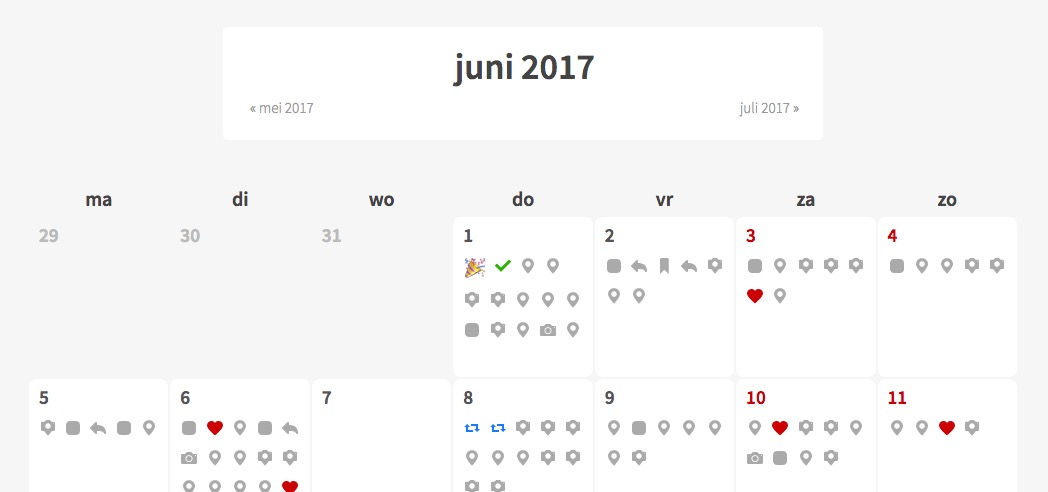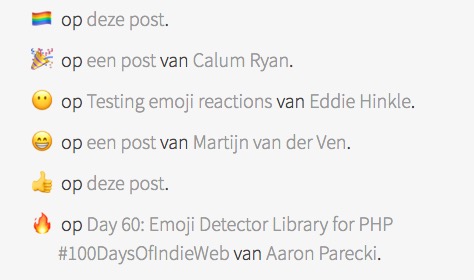reacji
This article is a stub. You can help the IndieWeb wiki by expanding it.
reacji is an emoji reaction, the use of a single emoji character in response to a post, introduced as a feature by Slack[1].
For collections of reacjis and examples see
Why
Why should you support posting reacji posts?
One great reason is to own your reactions(👍👎😆🎉😕❤️🚀👀) to GitHub issues and comments by posting them on your own site and POSSEing (e.g. using Bridgy).
How to
How to display
Display a reacji post itself with reply-context. Because a reacji is so minimal, it may appear meaningless or misleading without additional context. But because reacji are small, a normal reply context would be presentationally overwhelming and look awkward.
The reply context for a reacji should be similar to the reply context for a like, which tends to re-order the reply-context as the object of the like, rather than a header above it. At a minimum show the in-reply-to URL linked to itself, then additional information as it is available (e.g. name or summary of post), all of which can be wrapped in a u-in-reply-to h-cite hyperlink. Some sample hypertext designs:
- 👍 to http://tantek.com/2018/102/t9/css-2-2
- 👍 to tantek.com’s post
- 👍 to CSS 2.2
How to markup
Markup a reacji response post as follows:
Post a reply (How to markup) where the content is a single emoji character. Thus u-in-reply-to is required.
Note: if there is HTML in the content property, it may mess with emoji detection, so you should use p-content, rather than e-content for reacji reply posts.
<p class="h-entry">
<span class="p-name p-content">👍</span>
to
<a class="u-in-reply-to h-cite"
href="http://tantek.com/2018/102/t9/css-2-2">CSS 2.2</a>
...
<a class="u-url"
href="...permalink of post...">
<time class="dt-published">2018-05-01 11:00-0700</time>
</a>
</p>
Can use div or li or even span instead of (or around) the p element depending on what works for your site and context, e.g. on a permalink or in-stream. Note the reply-context comes after the content which is atypical for reply-context hypertext design/markup in general.
In addition, if your reacji is at least a somewhat positive approval, you may want to add a u-like-of class (in addition to u-in-reply-to) to your link to the original post, so that even if the receiver only supports likes, they can count your response as a like, until they add support for receiving reacji.
(complete h-entry reacji as a positive response code example would be nice here, perhaps with a thumbs-up or heart or smileyface emoji)
IndieWeb Examples
IndieWeb examples of reply posts consisting of a single emoji character (individual reacji posts)
Ben Roberts
![]() Ben Roberts supports individual reacji posts in Postly since 2015-12-16 (his birthday, send him a 🎂)
Ben Roberts supports individual reacji posts in Postly since 2015-12-16 (his birthday, send him a 🎂)
Aaron Parecki
 Aaron Parecki has been posting reacji since 2015-12-16.
Aaron Parecki has been posting reacji since 2015-12-16.
Tantek
 Tantek Çelik has been posting reacji since 2015-12-16.
Tantek Çelik has been posting reacji since 2015-12-16.
- http://tantek.com/2015/350/f1
- is also a like post (hence the /f in the URL) for fallback purposes, so that targets that understand likes but not reacji at least get the positive sense of the reacji being communicated. This method only makes sense for like-like reacji, but that's an acceptable limitation.
More recently (since 2018-04-13), reacji being posted as reply posts with a single emoji, e.g.:
Since 2018-05-02, showing in-stream mini-reply-contexts of the form:
👍 to issue 2588 of GitHub project “csswg-drafts”
Sebastiaan Andeweg
 Sebastiaan Andeweg sends reacji since 2017-02-20
Sebastiaan Andeweg sends reacji since 2017-02-20
Month view on Seblog containing a reacji post in the middle of likes, reposts, photos, checkins and an rsvp 'yes'.
Feed of reacji on Seblog, consisting of six separate reacji posts, in the format: "[emoji] on [post name] by [author name]."
Peter Molnar
![]() Peter Molnar used to display reacji with Wordpress, then had them removed; now they are back again, but since it's a static site, they are display with significant delays - 2017-06-01
Peter Molnar used to display reacji with Wordpress, then had them removed; now they are back again, but since it's a static site, they are display with significant delays - 2017-06-01
(permalinks needed that show displaying reacji from others)
Marty McGuire
 Marty McGuire has been posting reacji since at least 2017-10-23.
Marty McGuire has been posting reacji since at least 2017-10-23.
- Post is in-reply-to the original post
- Content is single emoji character
Silo Examples
Twitter seemed ready to roll out official support for 'reacji' but it was never widely released:
Without official support people have been experimenting on their own...
reacjweets
There are examples of individuals posting reacji as tweets (reacjweets as it were)
emoji survey
A tweet author can simulate a limited curated set of reacji by posting a survey with only single-emoji responses. E.g.
Implementations
Services
Brainstoming
Reply Context
 Tantek Çelik thoughts on reacji reply context design, deployed since brainstorming, have been incorporated into "How to display" above.
Tantek Çelik thoughts on reacji reply context design, deployed since brainstorming, have been incorporated into "How to display" above.
Criticism
- We should call this reactions instead of reacji. The rest of the industry already does - Slack, Facebook, GitHub, etc. Common terminology is more valuable than minor semantic differences. (Lots more discussion in IRC.) -
 Ryan Barrett
Ryan Barrett - +1
 Anthony Ciccarello Totally agree. Reactions is more in line with what I'd call similar features.
Anthony Ciccarello Totally agree. Reactions is more in line with what I'd call similar features. - +1 I agree and marked this as such in the Rust IndieWeb library —
Jacky Alciné - 2022-12-17 12:27 EST
- -0
 Tantek Çelik: technically yes, reacji *are* all reactions because they’re a proper subset of reactions which also include likes, reposts, bookmarks and other "one-click" / "one-keypress" actions taken in reaction (as it were) to posts. However calling reacji "reactions" is imprecise when you want to *only* talk about reacji.
Tantek Çelik: technically yes, reacji *are* all reactions because they’re a proper subset of reactions which also include likes, reposts, bookmarks and other "one-click" / "one-keypress" actions taken in reaction (as it were) to posts. However calling reacji "reactions" is imprecise when you want to *only* talk about reacji.
See Also
(need to reprocess the below to determine if they’re more relevant to individual reacji posts (this page), or displaying received reacjis on a post (reacjis):
- http://www.kevinmarks.com/notinourstars.html
- https://m.signalvnoise.com/introducing-boosts-an-all-new-way-to-show-your-support-in-basecamp-fae325634998
- https://blog.disqus.com/reactions-a-new-way-for-readers-to-engage
- Reactions plugin - a beta test plugin for supporting reacji that was being contemplated for inclusion in WordPress core.
- https://twitter.com/obra/status/1220470852799598599
- "When the heck did Twitter DMs get reactji?" @obra January 23, 2020
- How to display when you’ve received them, consider collating same reacji with different skin tones, per Slack update 2021 March: https://twitter.com/erondu/status/1370207492240777217
- "Love this small, yet super inclusive iteration from @SlackHQ
When people react with the same emoji but different skin tones, it groups them and shows one count" @erondu March 12, 2021
- "Love this small, yet super inclusive iteration from @SlackHQ
- Plural reacjis per https://www.macmillandictionary.com/us/buzzword/entries/reacji.html
- Adding Reacji support to my Micropub editor
- Beware of using/showing angry reacjis:
from https://www.theatlantic.com/ideas/archive/2021/10/facebook-papers-democracy-election-zuckerberg/620478/, emphasis addedIn November 2019, Facebook staffers noticed they had a serious problem. Facebook offers a collection of one-tap emoji reactions. Today, they include “like,” “love,” “care,” “haha,” “wow,” “sad,” and “angry.” Company researchers had found that the posts dominated by “angry” reactions were substantially more likely to go against community standards, including prohibitions on various types of misinformation, according to internal documents.
- Tip: Avoid prioritizing (or maybe even showing?) negative reacjis: 2021-10-26 Washington Post: Five points for anger, one for a ‘like’: How Facebook’s formula fostered rage and misinformation / Facebook engineers gave extra value to emoji reactions, including ‘angry,’ pushing more emotional and provocative content into users’ news feeds
- Open Heart Protocol describes sending a single emoji in reaction to a URL
- Emoji reactions in Gmail, sent as a full email fallback to senders who aren’t using Gmail https://support.google.com/mail/answer/14080429


